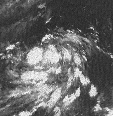1966 Pacific typhoon season
| 1966 Pacific typhoon season |

Season summary map
|
| Seasonal boundaries |
| First system formed |
April 3, 1966 |
| Last system dissipated |
December 31, 1966 |
| Strongest storm |
|
| Name |
Kit |
| • Maximum winds |
315 km/h (195 mph)
(1-minute sustained) |
| • Lowest pressure |
880 hPa (mbar) |
| Seasonal statistics |
| Total depressions |
51 |
| Total storms |
30 |
| Typhoons |
20 |
| Super typhoons |
3 |
| Total fatalities |
997–1,146 total |
| Total damage |
At least $377.6 million (1966 USD) |
| Related articles |
|
|
Pacific typhoon seasons
1964, 1965, 1966, 1967, 1968
|
| Category 2 typhoon (SSHWS) |
|
|
| Duration |
April 3 – April 15 |
| Peak intensity |
155 km/h (100 mph) (1-min) 979 hPa (mbar) |
| Category 4 typhoon (SSHWS) |
|
|
| Duration |
May 10 – May 22 |
| Peak intensity |
220 km/h (140 mph) (1-min) 970 hPa (mbar) |
| Category 2 typhoon (SSHWS) |
|
|
| Duration |
May 21 – May 31 |
| Peak intensity |
155 km/h (100 mph) (1-min) 970 hPa (mbar) |
| Category 5 super typhoon (SSHWS) |
|
|
| Duration |
June 20 – June 29 |
| Peak intensity |
315 km/h (195 mph) (1-min) 880 hPa (mbar) |
| Tropical storm (SSHWS) |
|
|
| Duration |
July 8 – July 14 |
| Peak intensity |
110 km/h (70 mph) (1-min) 992 hPa (mbar) |
| Category 2 typhoon (SSHWS) |
|
|
| Duration |
July 14 – July 18 |
| Peak intensity |
155 km/h (100 mph) (1-min) 987 hPa (mbar) |
| Category 1 typhoon (SSHWS) |
|
|
| Duration |
July 15 – July 19 |
| Peak intensity |
120 km/h (75 mph) (1-min) 995 hPa (mbar) |
| Category 2 typhoon (SSHWS) |
|
|
| Duration |
July 22 – July 28 |
| Peak intensity |
155 km/h (100 mph) (1-min) 977 hPa (mbar) |
| Tropical storm (SSHWS) |
|
|
| Duration |
July 29 – August 3 |
| Peak intensity |
85 km/h (50 mph) (1-min) 991 hPa (mbar) |
The 1966 Pacific typhoon season was an active season, with many tropical cyclones having severe impacts in China, Japan, and the Philippines. Overall, there were 49 tropical depressions declared officially or unofficially, of which 30 officially became named storms; of those, 20 reached typhoon status, while 3 further became super typhoons by having winds of at least 240 km/h (150 mph). Throughout the year, storms were responsible for at least 997 fatalities and $377.6 million in damage; however, a complete record of their effects is unavailable.
It is widely accepted that wind estimates in the Western North Pacific during the reconnaissance era prior to 1988 are subject to great error. In many cases, intensities were grossly overestimated due to a combination inadequate technology and a lesser understanding of the mechanics behind tropical cyclones as compared to the present day. Additionally, methodologies for obtaining wind estimates have changed over the decades and is not the same today as in 1966. A joint reanalysis of typhoons from 1966–1987 was conducted by the Cooperative Institute for Research in the Atmosphere at Colorado State University and the United States Naval Research Laboratory in 2006 to correct some of these errors. Many storms in 1966 received strength reductions as a result of this study; however, the results of the research have not been implemented into the official database. Notably the number of major typhoons, Category 3 equivalent or higher on the Saffir–Simpson hurricane wind scale, was reduced from eight to six, including the removal of a Category 5.
The western Pacific basin covers the Pacific Ocean, north of the equator and west of the International Date Line. Storms that form east of the date line and north of the equator are called hurricanes; see 1966 Pacific hurricane season. Tropical Storms formed in the entire west Pacific basin were assigned a name by the Joint Typhoon Warning Center (JTWC). The Japan Meteorological Agency (JMA) also monitored systems in the basin; however, it was not recognized as the Regional Specialized Meteorological Center until 1968. Tropical depressions that enter or form in the Philippine area of responsibility are assigned a name by the Philippine Atmospheric, Geophysical and Astronomical Services Administration (PAGASA), which can result in the same storm having two names; in these cases both storm names are given below, with the PAGASA name in parentheses.
...
Wikipedia



















